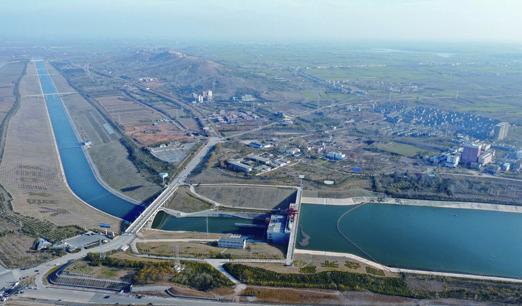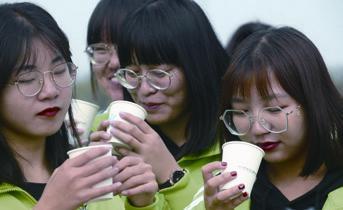A Running Lifeline
2019-12-27ByWangHairong
By Wang Hairong

As deputy mayor of Shiyan in Hubei Province in central China, Wu Ye has many things to be proud of. The city is a tourist attraction reputed for rare dinosaur egg fossils and the Wudang Mountain, a Taoist mecca. It is also a well-known automobile production base.
But perhaps its best claim to modern fame is supplying the headwaters for the middle route of the South-to-North Water Diversion Project. The engineering marvel diverts water from the Yangtze River in the south to the drought-prone north with a network of canals and tunnels. The Danjiangkou Reservoir is the source of the water for the middle route that eventually reaches Beijing.
“In the past five years, clear water from the reservoir has moistened the north and produced tremendous economic, social and ecological benefits,” Wu said on December 12, at a press conference held in Beijing to mark the fifth anniversary of the middle routes becoming operational.
Some 60 percent of the reservoirs water area falls under Shiyans jurisdiction. The rest is located in Nanyang, a city in neighboring Henan Province.
Health benefits
Under the water transfer project, nearly 30 billion cubic meters has been diverted, directly benefiting more than 120 million people, according to Jiang Xuguang, Vice Minister of Water Resources, at another press conference held on the same day.
Overall, the project has supplied water to more than 40 large and medium-sized cities and 260-plus counties in north China, Jiang said. The water has become the lifeline of cities like Zhengzhou, capital of Henan, accounting for more than 80 percent of the water consumed.
The diverted water is healthier. In the Heilonggang area in Hebei Province in north China, it has benefited more than 5 million people with a long history of using high-fluorine and brackish water, he said.
Modern technology such as big data, cloud technology and the Internet of Things has ensured the safety and stability of the project. It has withstood extreme weather such as heavy rain, typhoon and cold spells without any accidents. The volume of diverted water is growing, and the quality is stable and up to standard, he added.
The biggest water transfer project in the world, the ambitious idea was conceived in 1952 by Chairman Mao Zedong when he inspected the Yellow River.
The water diversion is planned through three routes, the eastern, middle and western routes, each serving separate areas, except the coastal city of Tianjin near Beijing, which gets water from both the eastern and middle routes. The first phase of the eastern route, from Yangzhou in Jiangsu Province in the east to Tianjin, was put into operation in 2013. The western route is still under planning.
The first phase of the middle route, from the Danjiangkou Reservoir to Beijing, became functional on December 12, 2014, with the water arriving at the capital on December 27.
“In the past five years, Beijing has received more than 5.2 billion cubic meters of water. The water quality has remained stable at Grade II or above for surface water. Over 12 million Beijing residents have directly benefited from the project,” Liu Guangming, deputy head of the Beijing Water Authority, said. The quality of surface water in China is classified into six grades, with Grade I being the best.
Nearly 70 percent of the water entering Beijing is fed into municipal water supply pipelines, another 11 percent is stored in local reservoirs, and the rest flows into urban rivers and lakes to replenish groundwater. As a result, per-capita fresh water in the capital has risen from 100 cubic meters to 150 cubic meters, Liu said.
With phase I of the two routes running smoothly, Shi Chunxian, head of the Department of Planning and Programming, Ministry of Water Resources, talked about the next phase.

For the eastern route, more water will be drawn from the Yangtze and more pumping stations built. The middle route will have water diverted from the Yangtze into the Hanjiang River, a tributary of the Yangtze that flows through Hubei, so more water can be trans- ferred to the north in the future. Reservoirs will be built along the middle route to modulate the water flow. For the western route, the planning will be advanced.
Ecological benefits
The diverted water has arrested the decline of the groundwater level and deterioration in the hydrological environment, improving the ecology along the routes, Jiang said.
Before the diversion, every year Beijing suffered severe water deficit and had to extract groundwater and recycle used water. As a result, half the rivers in the city dried up, the groundwater table shrank and there was land subsidence, Liu said.
According to Jiang, more than 30 rivers along the middle route have been replenished with the diverted water and the surface area of rivers, lakes and wetlands along the route has expanded.
On October 13, a boat race was held on the Hutuo River in Shijiazhuang, capital of Hebei. The river had dried up for about four decades. But today, it is filled with diverted water that has made the environment scenic and become a source of fun for the people.
The groundwater level has risen significantly. Jiang said in October, the average depth of groundwater in Beijings plain area was 22.81 meters. The groundwater table was 0.63 meter higher than last years figure, meaning groundwater reserves had increased by 320 million cubic meters.
Quality development
The project has also boosted development in the beneficiary areas, including the coordinated development of Beijing, Tianjin and Hebei and the development of Xiongan New Area, a newly developed place near Beijing where the capitals non-core functions are being shifted. Jiang said over the past five years, the project has estimatedly supplied water for producing 4 trillion yuan($560 billion) of GDP in the recipient areas.
In particular, it has spurred industrial structural adjustment. A large number of polluting enterprises along the routes have been shut down, peoples awareness to save water has increased, and water-efficient industries are being encouraged, he said.
Pollution control is crucial to the success of the water diversion project. Before the project was put into operation, the water quality along the trunk line south of the Yellow River was poor, Shi said. Out of the 36 monitored sections, 32 had water below Grade V, the poorest quality, not even suitable for industrial use.
But in 2018, the quality of more than 80 percent of the monitored sections along the middle route had Grade I water. In 2019, the proportion is expected to reach 88 percent.
According to Jiang, now water along both the eastern and middle routes meets standards for drinking water sources.
In November 2018, when Vice President Wang Qishan inspected the Danjiangkou Reservoir, he drank water directly drawn from the reservoir, which demonstrated the central leaderships confidence in Shiyans water quality protection, Deputy Mayor Wu said.
He added that Shiyan was among the first in the nation to adopt a river chief system, which holds officials responsible for environmental protection. The city has relocated or shut down 179 animal farms, removed aquatic farms and closed over 300 polluting enterprises. Afforestation efforts have brought its forest cover ratio to 64.92 percent.
In Beijing, stringent water resource management policies have been implemented and remarkable progress has been made in water saving, Liu said. From 2014-18, water consumption per unit of GDP decreased by 22.59 percent, and the city saved 529 million cubic meters of water during the period.
When one drinks water, one must not forget where it comes from, goes a Chinese saying. People at the water sources have made a great contribution to the project through relocation and environmental protection and today Beijing is requiting the contribution by reciprocal assistance.
Sun Zhansheng, deputy head of the Beijing Poverty Alleviation Office, said Beijing has supported Hubei and Henan through transfer payment. It has also provided technological and other support to promote their social and economic development.
